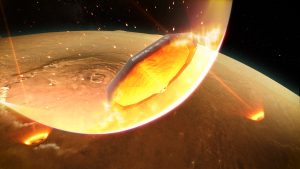
Stony Materials Initial Analysis Team results for the history of asteroid Ryugu
The “Stony Materials Initial Analysis Team” have published their first results from the initial analysis of the asteroid Ryugu sample returned by the Hayabusa2 mission in the international journal Science.
The team analysed 17 grains and fine grained powder from the asteroid Ryugu sample. 7 sample grains were from the site of the first touchdown (Chamber A) and 10 grains were from the site of the second touchdown (Chamber C), where subsurface material is expected to have been collected.
Key points from this paper:
- Remnant magnetism was detected in micro-crystals of magnetite. These magnetic minerals act like many small magnets and behave like a natural hard disc, recording a magnetic field that the rock felt more than 4.6 billion years ago.
Asteroid Ryugu is believed to be a fragment from a larger parent asteroid that was destroyed during a collision. The homogenous appearance of Ryugu implies that the parent body had not differentiated to form a dense iron-rich core capable of generating a magnetic field. The recorded magnetic field in Ryugu’s grains is therefore thought to be the magnetic field in the primordial solar nebula that surrounded the young Sun and formed the Solar System. This suggests that Ryugu’s parent body was formed in the primordial solar nebula, very early in the formation of the Solar System.

- Trapped fluid inclusions were discovered in a large pyrrhotite (iron sulphide) crystal in one of the sample grains. The fluid was found to contain H2O and CO2, as well as sulphur species and organic molecules. The presence of water and CO2 indicates that Ryugu’s parent body formed far away from the Sun, where H2O and CO2 could freeze into solids that could be included in the asteroid.
- Small (< 30 micron) calcium-aluminium-rich inclusions (CAIs) and fragments that resemble chondrules were identified in the Ryugu sample. These particles are formed at high temperatures (>1000°C) close to the Sun. As Ryugu’s parent body is thought to have formed far from the Sun, this indicates large-scale mixing of material between the inner and outer Solar System before the formation of the planets.
The rarity and small size of the CAIs and chondrules in the Ryugu sample is similar to that observed in comets, such as the sample retuned by NASA’s Stardust mission from the coma of comet 81P. However, the elemental abundance ratio of carbon-to-silicate (C/Si = 0.338) is lower than that of comets. This suggests Ryugu did not originate from a comet, but does support a formation of Ryugu’s parent body far from the Sun, possibly outside the orbit of Jupiter.
After formation, the Ryugu’s parent body would have been scattered inwards and ultimately fragmented. - Computer simulations of the evolution of Ryugu’s parent from formation to its destruction in a catastrophic impact was run, using the physical properties of the Ryugu sample measure in the analysis. This is the first time that measurements of the hardness and thermal diffusivity of actual astroid samples were incorporated into a simulation of the evolution of an asteroid.
The simulation followed the young parent asteroid initially heated by the radioactive decay of 26Al. This melted the water ice and led to reactions between the water and rock (formation of hydrous minerals), which released further heat. Minerals in the Ryugu sample indicate that these water and rock reactions occurred at temperatures mostly around 50°C over the next 3 million years (consistent with results from the [Chemical Initial Analysis team])
Material near the colder surface in the simulation of Ryugu’s parent body experienced less ice melting and therefore reduced reactions between water and rock. This gave a gradient in water content, with rocks deeper underground containing more water.
The simulation revealed that the collision that destroyed the parent asteroid likely only raised pressure and temperature of material close to the impact site. The fragments that would become Ryugu are consistent with material far from the impact region in the parent body, and from a range of different depths within the asteroid.

- On one of the grains, a coral-shaped growth of copper sulphide (CuS) crystals was discovered, showing a root, branched and disc-shaped crystals. These coral-like crystals suggest that an environment not dissimilar from Earth’s oceans existed in the interior of Ryugu’s parent body.
The Stony Material analysis team is one of the six initial analysis groups which together with the two Phase-2 specialist institutes, are undertaking the first high-precision examination of the Ryugu sample after the initial cataloguing (Phase-1). The toolbox of the Stony Material team is light reflection spectra, and non-destructive material analysis using synchrotron radiation high-energy beams to obtain three dimensional internal structure and element distribution, and electron microscope observations of the sample microstructure.
Details of the different initial analysis teams can be found in this [Hayabusa2 mission press release].
The full JAXA press release written by lead author Professor Nakamura Tomoki (Tohoku University) can be read [here].
Publication information
Journal: Science
DOI: 10.1126/science.abn8671
Title: Formation and evolution of carbonaceous asteroid Ryugu: Direct evidence from returned samples
Authors: Nakamura, Matsumoto, Amano, Enokida, Zolensky, Mikouchi, Genda, Tanaka et al.
Further information:
Hayabusa2 mission website
Astromaterials Science Research Group website
 Previous Post
Previous Post Next Post
Next Post






